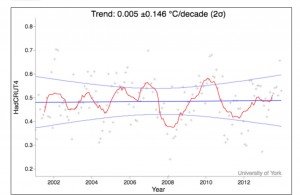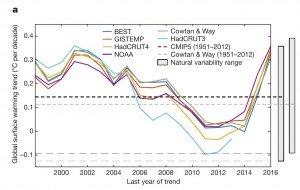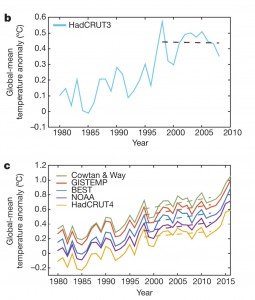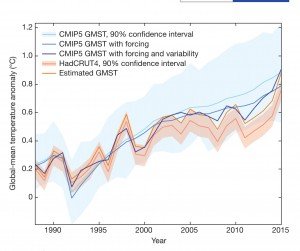New Study Confirms: The Warming 'Pause' Is Real And Revealing
A new paper has been published in the Analysis section of Nature called Reconciling controversies about the 'global warming hiatus.' It confirms that the 'hiatus' or 'pause' is real. It is also rather revealing.
It attempts to explain the 'Pause' by looking into what is known about climate variability. They say that four years after the release of the IPCC AR5 report, which contained much about the 'hiatus' it is time to see what can be learned.
One could be a little sarcastic in saying why would Nature devote seven of its desirable pages to an event that some vehemently say never existed and maintain its existence has been disproved long ago. Now, however, as the El Nino spike of the past few years levels off, analysing the 'pause' seems to be coming back into fashion.
The authors of this recent paper delicately tread a line between the two opposing camps saying, on the one hand, that both sides have a point and their particular methods of analysis are understandable. But on the other hand they make it clear that there is a real event that needs studying.
As someone who has paid close attention to the 'pause' for almost a decade I am perhaps more attentive than most when it comes to a retelling of the history of the idea and the observations.
The authors say the pause started with claims from outside the scientific community. Well, yes and no. It was tentatively suggested in 2006 and 2007 by climate sceptics many of whom were experienced scientists and quite capable of reading a graph and calculating statistics. A decade after it was raised, every time the 'pause' is debated it is a tribute to those who first noticed it and faced harsh criticism. It was the sceptics who noticed the 'pause,' and in doing so made a valuable contribution to science. For years it was only analysed and discussed on the blogosphere before journals took notice.
There is nothing new in their recent paper or that hasn't been discussed by the GWPF. Perhaps that will give pause for thought for some who see battle lines drawn between pause supporters (sceptics) and pause busters (scientists).
What the authors miss, with their three definitions of the pause, is a simple fact we have often pointed out. Look at HadCRUT4 from 2001 (after the 1999-2000 El Nino/La Nina event) until 2014 (before the start of the recent El Nino event) and you will see the temperature is flat. Apart from the recent El Nino there has been no global increase since 2001, even though there have been El Ninos and La Ninas in that period. Now that's what I call a pause.
I will leave it to the reader to calculate the trend, and the error of the trend for the same period using other global surface temperature data sets. The duration of the pause is about half of the nominal 30-year basic climate assessment period, so if it resumes in the next few years it may become the dominant climate event of recent times. The pause ended not because of gradual global warming but because of a natural weather event whose temporary increased rate of global warming was far too large to be anthropogenic. This didn't stop some from claiming we had entered a period of catastrophic global warming.

Look at their Fig 1 showing trends in global temperature data sets. It shows that since about 2000 the trend in all data sets has been decreasing. This was only halted by the recent El Nino. Note that all the variations on the graph are said to be within the bounds of natural variability according to the authors, indicating that nothing unusual has happened over the duration of the graph.

Consider also their figure 2b and c. It shows HadCRUT3 from 1980 -2008 and points out the recent pause period. It then shows five global temperature data sets from 1980 - 2015 showing that the pause has gone away. Never mind that the reason why the pause has stopped is not a climatic one, but due to the short-term El Nino.

Look also at their Fig 5 which is said to reconcile observations and computer models showing that there is no discrepancy. Again it is the recent El Nino that brings models and data together. Without the introduction of this short-lived weather event the climate models would obviously be running too warm.

All this negates the paper's aim to explain the pause in terms of what is known about climate variability.
There is also a commentary on the paper published in Nature's news and views section by Risbey and Lewandowsky which is absurd. They are wrong in their views about HadCRUT4 and flat periods, see above. They point out that the data sets continue to show significant warming trends when the trend length exceeds 16 years. This is an obvious point when looking at the rise in global temperature seen in the years prior to the 1998 El Nino event. They should also look at Fig 1 again and bear in mind what I say about El Ninos.
The pause has been extremely valuable and illuminating for climate science. A decade ago it was held that the anthropogenic signal of global warming was strong. Only when surface temperatures did not increase by the 0.3°C per decade most climate models had predicted that qualifications were made. Natural decadal variability was used to explain the lack of temperature rise and it resulted in a gradual change of view.
Now it was claimed that the anthropogenic signal was being obscured by decadal climatic variability and it would be several decades before it emerged and exceeded it, as Meehl et al said in Nature Climate Change, “Longer-term externally forced trends in global mean surface temperatures are embedded in the background noise of internally generated multidecadal variability.”
Whether the pause will return after the recent El Nino and its aftermath settles down remains to be seen. From its sceptical beginnings the pause has become the major controversy and debating point in climate science. Despite ongoing attempts to either deny it altogether or to find new reasons for its existence, nobody really knows what caused it or whether it will be re-established.
Feedback: david.whitehouse@netzerowatch.com
